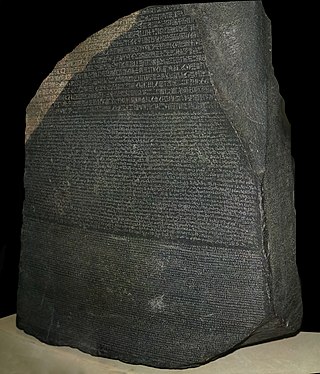
Aswan is a city in Southern Egypt, and is the capital of the Aswan Governorate.

The British Museum is a public museum dedicated to human history, art and culture located in the Bloomsbury area of London. Its permanent collection of eight million works is among the largest and most comprehensive in existence. It documents the story of human culture from its beginnings to the present. The British Museum was the first public national museum to cover all fields of knowledge.

The Rosetta Stone is a stele composed of granodiorite inscribed with three versions of a decree issued in Memphis, Egypt, in 196 BC during the Ptolemaic dynasty on behalf of King Ptolemy V Epiphanes. The top and middle texts are in Ancient Egyptian using hieroglyphic and Demotic scripts respectively, while the bottom is in Ancient Greek. The decree has only minor differences between the three versions, making the Rosetta Stone key to deciphering the Egyptian scripts.

Egyptology is the study of ancient Egyptian history, language, literature, religion, architecture and art from the 5th millennium BC until the end of its native religious practices in the 4th century AD. A practitioner of the discipline is an "Egyptologist". In Europe, particularly on the Continent, Egyptology is primarily regarded as being a philological discipline, while in North America it is often regarded as a branch of archaeology.

Memphis or Men-nefer was the ancient capital of Inebu-hedj, the first nome of Lower Egypt that was known as mḥw ("north"). Its ruins are located near the present-day town of Mit Rahina. Its name is derived from the late Ancient Egyptian name for Memphis mjt-rhnt meaning "Road of the Ram-Headed Sphinxes", 20 km (12 mi) south of Giza in Greater Cairo, Egypt.

Heliopolis was a major city of ancient Egypt. It was the capital of the 13th or Heliopolite Nome of Lower Egypt and a major religious centre. It is now located in Ayn Shams, a northeastern suburb of Cairo.
An obelisk is a tall, four-sided, narrow tapering monument which ends in a pyramid-like shape or pyramidion at the top. Originally constructed by Ancient Egyptians and called tekhenu, the Greeks used the Greek term obeliskos to describe them, and this word passed into Latin and ultimately English. Ancient obelisks are monolithic; they consist of a single stone. Most modern obelisks are made of several stones.

Luxor is a modern city in Upper (southern) Egypt which includes the site of the Ancient Egyptian city of Thebes.

Articles related to Egypt include:

Cleopatra's Needles are a separated pair of ancient Egyptian obelisks now in London and New York City. The obelisks were originally made in Heliopolis during the New Kingdom period, inscribed by the 18th dynasty pharaoh Thutmose III and 19th dynasty pharaoh Ramesses II. They were later moved to the Caesareum of Alexandria, which had been conceived by Ptolemaic Queen Cleopatra VII, for whom the obelisks are named. They stood in Alexandria for almost two millennia until they were re-erected in London and New York City in 1877 and 1881 respectively. Together with Pompey's Pillar, they were described in the 1840s in David Roberts' Egypt and Nubia as "[the] most striking monuments of ancient Alexandria".

Psamtik II, known by the Graeco-Romans as Psammetichus or Psammeticus, was a king of the Saite-based Twenty-sixth Dynasty of Egypt. His prenomen, Nefer-Ib-Re, means "Beautiful [is the] Heart [of] Re." He was the son of Necho II.

Nectanebo I was an ancient Egyptian pharaoh, founder of the last native dynasty of Egypt, the 30th.

The Queen Elizabeth II Great Court, commonly referred to simply as the Great Court, is the covered central quadrangle of the British Museum in London. It was redeveloped during the late 1990s to a design by Foster and Partners, from a 1970s design by Colin St John Wilson. The court was opened by Queen Elizabeth II in 2000.

The Department of Ancient Egypt and Sudan is a department forming an historic part of the British Museum, with Its more than 100,000 pieces making it the largest and most comprehensive collection of Egyptian antiquities outside the Egyptian Museum in Cairo.

The Obelisk of Theodosius is the Ancient Egyptian obelisk of Pharaoh Thutmose III re-erected in the Hippodrome of Constantinople by the Roman emperor Theodosius I in the 4th century AD.

The Luxor Obelisks are a pair of ancient Egyptian obelisks, over 3,000 years old, carved to stand either side of the portal of the Luxor Temple in the reign of Ramesses II. The right-hand (western) stone, 23 metres (75 ft) high, was moved in the 1830s to the Place de la Concorde in Paris, France, while the left-hand (eastern) obelisk remains in its location in Egypt.

The colossal red granite statue of Amenhotep III is a granite head of the 18th Dynasty ancient Egyptian Pharaoh Amenhotep III. Dating from around 1370 BCE, it was found in the temple enclosure of Mut at Karnak in Upper Egypt. Two parts of the broken colossal statue are known: the head and an arm. Both parts are now in the British Museum.
This page list topics related to ancient Egypt.
The decline of ancient Egyptian religion is largely attributed to the spread of Christianity in Egypt. Its strict monotheistic nature not allowing the syncretism seen between ancient Egyptian religion and other polytheistic religions, such as that of the Romans. Although religious practices within Egypt stayed relatively constant despite contact with the greater Mediterranean world, such as with the Assyrians, Persians, Greeks, and Romans, Christianity directly competed with the native religion. Even before the Edict of Milan in AD 313, which legalised Christianity in the Roman Empire, Egypt became an early centre of Christianity, especially in Alexandria where numerous influential Christian writers of antiquity such as Origen and Clement of Alexandria lived much of their lives, and native Egyptian religion may have put up little resistance to the permeation of Christianity into the province.

















